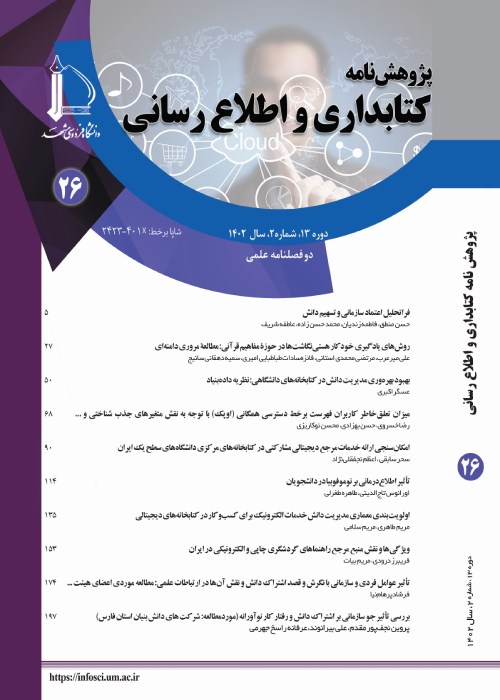Bibliographic Relationships among Iranian Musical Bibliographic Entities from FRBR Perspective
Music Information Retrieval (MIR) involves searching and organizing large collection of music information and requires a conceptual model for bibliographic relationships in various works. Bibliographic relationships define all relationships involved in cataloging bibliographic units. The purpose of this research is to study the characteristics of Iranian musical bibliographic records by analyzing their work-to-work relationships based on the Functional Requirements for Bibliographic Records (FRBR) model.
This study uses a quantitative approach and practical method in order to analysis bibliographic data. The research method is a descriptive survey. The statistical population includes all Iranian musical bibliographic records available in the OPAC of the National Library of Iran from 2011 to 2018 and includes 1367 records for musical works. Data gathering method includes structural observation and documentary method and data gathering tool is a check list. The bibliographic relationships among records are studied according to the table of work-to-work relationships noted in IFLA final report.
Of 1367 bibliographic records that belong to musical works, 320 (23/4%) have work-to-work bibliographic relationships. The highest percentage of work-to-work relationships consists of 304 (95%) adaptive relationships and 16 (5%) complementary relationships. Other work-to-work relationships such as supplement, succession, transformation, summarization and imitation ones do not exist among Iranian musical works. The distribution of relationships in referential and autonomous works consists of adaptation with 301 (94.69%), incidental music with 16 (5%), fantasy with 2 (0.62%) and variation with 1 (0.31%). The rest of the sub-relationships types, as well as main relationships are not seen among the musical works.
The high percentage of Iranian musical works recorded in the National Library of Iran includes traditional Persian music and principal musical modal systems (Dastgah) which, cannot be traced in the features of the international music. Therefore, sub-relationships such as variation, harmonization, cadenza, libretto (operas), etc., as defined in the IFLA report for bibliographic relationships of a work were not mentioned among such musical compositions based on Dastgah music. Most of Iranian musical works are adapted from poetry and lyrics. The distribution of bibliographic relationships among Iranian musical works is only in two adaptation and complement types. Sub-relationships like Cadenza, Libretto, Choreography, Variation, Harmonization and Fantasy, unique to musical works does not exist in most of existing Iranian musical works. Hence, considering the significant difference between Iranian musical works and international musical works, using of FRBR for Iranian musical works in work-to-work relationships is not economically benefit.
- حق عضویت دریافتی صرف حمایت از نشریات عضو و نگهداری، تکمیل و توسعه مگیران میشود.
- پرداخت حق اشتراک و دانلود مقالات اجازه بازنشر آن در سایر رسانههای چاپی و دیجیتال را به کاربر نمیدهد.


